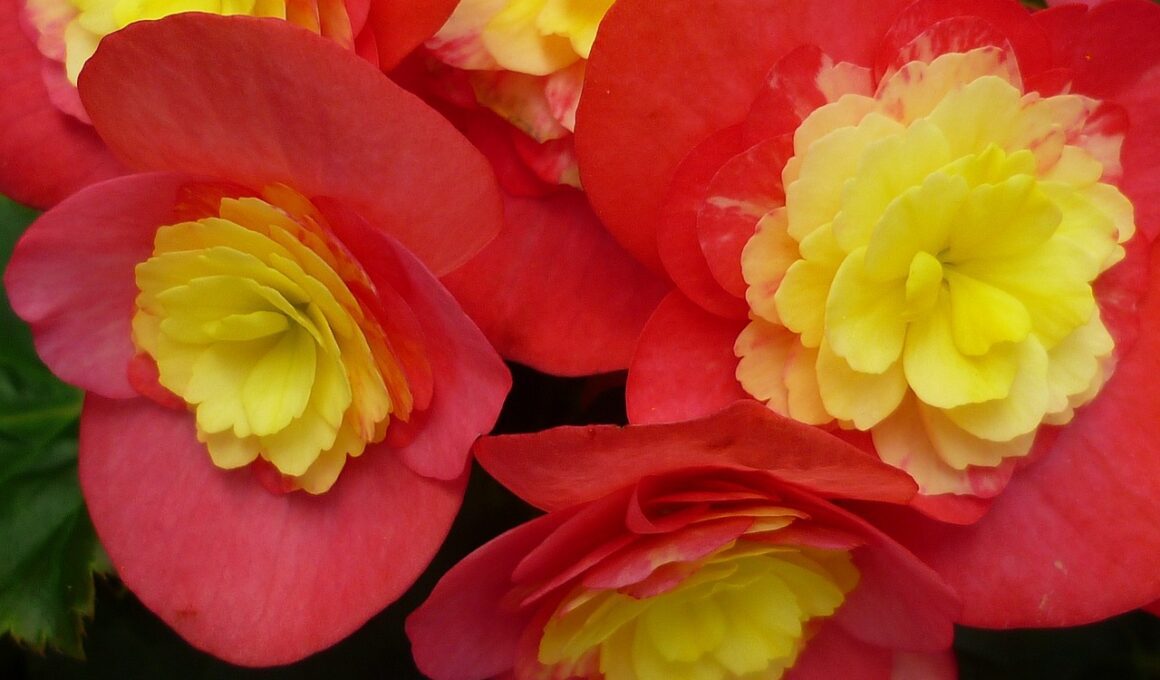Are you considering pruning your begonias and wondering if they will come back? Don’t worry, cutting back your begonias can actually promote healthy growth and ensure they come back stronger than ever.
Begonias are known for their vibrant blooms and lush foliage, but without proper maintenance, they can become overgrown and leggy. By cutting back your begonias, you can encourage new growth and prevent the plant from becoming too tall and spindly.
But before you grab those pruning shears, it’s important to understand the basics of begonia pruning and how it can affect the plant’s growth. In this article, we’ll take a closer look at the benefits of cutting back begonias, how to do it properly, and what factors can impact the growth of your begonias after pruning.
So let’s get started and ensure your begonias thrive in your garden.
Understanding the Basics of Begonia Pruning
Get ready to give your begonias a fresh and rejuvenated look with some basic pruning techniques! Pruning is an essential part of maintaining the health and beauty of your begonias. Proper pruning techniques can help your begonias grow fuller, bushier, and more vibrant.
Pruning techniques involve removing dead, damaged, or diseased leaves, stems, and flowers. This process not only enhances the appearance of your begonias, but it also promotes new growth. You can also prune your begonias to control their size and shape.
Timing is critical when it comes to pruning begonias. The best time to prune your begonias is in the early spring or late winter before new growth appears. Pruning during this time will encourage new growth and help your begonias bloom beautifully during the upcoming growing season.
In summary, pruning is an essential part of maintaining the health and beauty of your begonias. Pruning techniques involve removing dead, damaged, or diseased leaves, stems, and flowers, promoting new growth and enhancing the appearance of your begonias. Timing considerations are crucial when it comes to pruning your begonias, and the best time to prune is in the early spring or late winter before new growth appears.
So, grab your pruning shears and get ready to give your begonias the care they deserve!
Benefits of Cutting Back Begonias
Trimming begonias has numerous advantages. It promotes new growth and improves plant health. By cutting back your begonias, you can help them thrive and produce beautiful blooms.
Here are some benefits of cutting back your begonias:
-
Improved blooming: When you cut back your begonias, you remove dead flowers and encourage the plant to produce new ones. This leads to more vibrant and abundant blooms.
-
Healthier foliage: Trimming back your begonias can help prevent disease and pest infestations. It also allows more light and air to reach the leaves, which can lead to healthier and stronger foliage.
-
Fostering new growth: By cutting back your begonias, you stimulate the growth of new branches and leaves. This can lead to a fuller and more attractive plant.
Overall, cutting back your begonias is a simple but effective way to improve their appearance and health. With just a few snips, you can encourage new growth and promote a more vibrant and abundant display of blooms.
So if you want your begonias to look their best, grab your pruning shears and get to work. With a little effort, you can help your plants thrive and bring joy to your home or garden.
Are Cosmos Perennial Plants That Return Yearly?
Cosmos perennial plants, also known as cosmos recurring yearly, are indeed a beautiful addition to any garden. These vibrant blooms effortlessly return year after year, adding a touch of color and elegance. With their sturdy nature and ability to self-seed, cosmos recurring yearly truly make for a delightful and low-maintenance choice for those seeking long-lasting floral displays.
How to Cut Back Begonias
You’ll be amazed at how easy it is to give your begonias a fresh start and watch them flourish with these simple cutting techniques. Pruning your begonias is a great way to rejuvenate growth and promote healthy development. With the right tools and knowledge, you’ll be able to cut back your begonias in no time.
To get started, you’ll need a sharp pair of pruning shears or scissors. It’s important to use a clean, sharp tool to prevent damaging the plant and spreading disease. Once you have your tool, take a look at your begonia and identify any dead or damaged stems. These should be cut back to the base of the plant. You can also trim back any leggy or overgrown stems to encourage fuller growth.
Here’s a table to help guide you through the pruning techniques:
| Type of Cut | Purpose | Where to Cut |
|---|---|---|
| Pinching | Promotes bushier growth | Pinch off the tips of stems |
| Thinning | Reduces overcrowding | Cut stems back to a side shoot or main stem |
| Heading | Controls plant size | Cut back a stem to a desired length |
By using these pruning techniques, you’ll be able to give your begonias a fresh start and promote healthy growth. Remember to always use a sharp, clean tool and to avoid cutting too much at once. With a little bit of care and attention, your begonias will come back better than ever.
Factors That Affect Begonia Growth
Discovering the factors that impact the growth of your begonias can help you create the ideal environment for these beautiful plants to thrive.
The soil that begonias grow in is one of the most important factors to consider. Begonias prefer well-draining, slightly acidic soil that is rich in organic matter. If the soil is too compact or heavy, the roots may have difficulty absorbing the necessary nutrients and water.
Another factor to consider is the watering frequency. Begonias need consistent moisture, but overwatering can be just as harmful as underwatering. It’s important to let the soil dry out slightly between watering sessions to prevent the roots from rotting. A good rule of thumb is to water your begonias when the top inch of soil feels dry to the touch.
To ensure the healthy growth of your begonias, pay attention to their environment and make necessary adjustments. In addition to the soil and watering frequency, factors such as sunlight exposure and temperature can also impact their growth.
With proper care, you can expect your begonias to thrive and add beauty to your home or garden.
Monitoring Your Begonias After Pruning
Monitoring the growth and health of your begonias after pruning is essential for ensuring their continued vibrancy and beauty. While pruning can promote new growth and prevent overcrowding, it is possible to over-prune your begonias. Signs of over-pruning include stunted growth, yellowing leaves, and a lack of new blooms. If you notice these signs, it may be time to adjust your pruning habits or give your begonias some extra care.
To revive wilted begonia stems, start by watering your plant deeply and ensuring it is properly hydrated. Sometimes, wilting can be a sign of dehydration, so make sure to check the soil moisture regularly. If the soil is dry, water your plant thoroughly and consider adding a layer of mulch to help retain moisture. If your begonia stems continue to wilt, you may need to prune them back further to promote new growth.
To help monitor the health and growth of your begonias, use the following table to keep track of your pruning habits and any changes in your plant’s appearance:
| Date of Pruning | Amount of Growth | Appearance of Leaves | Blooming Status | Notes |
|---|---|---|---|---|
Remember, pruning can help your begonias thrive, but it’s important to monitor their health and growth regularly. By keeping an eye out for signs of over-pruning and taking steps to revive wilted stems, you can ensure your begonias continue to bring beauty and vibrancy to your garden or home.
Frequently Asked Questions
What are some common pests or diseases that affect begonias?
Begonia plants are prone to a few common pests and diseases that can affect their growth and overall health. The most common pests that affect begonias include spider mites, mealybugs, and thrips. These pests can be controlled by regularly inspecting your plants and treating them with insecticides or natural remedies like neem oil or soap sprays.
In addition to pests, begonias can also fall prey to diseases like powdery mildew, stem rot, and bacterial leaf spot. To prevent these diseases, make sure to avoid overwatering, keep the soil well-drained, and provide adequate air circulation.
If you notice any signs of pest infestations or diseases, act quickly to prevent further damage and keep your begonias healthy and thriving.
How often should I fertilize my begonias after pruning?
To keep your begonias healthy and thriving after pruning, it’s important to pay attention to the quality of the soil and fertilizers you use.
Soil quality is crucial as it provides the necessary nutrients and minerals for the plant’s growth. Choose well-draining soil that is enriched with organic matter.
Additionally, select the right fertilizers for your begonias. You can use a balanced fertilizer with equal amounts of nitrogen, phosphorus, and potassium, or opt for a slow-release fertilizer that gradually feeds the plant over time.
It’s recommended to fertilize your begonias every two to three weeks during the growing season. By using high-quality soil and fertilizers, you can ensure that your begonias will come back stronger and healthier after pruning.
Can I propagate begonias from cuttings taken during pruning?
If you’re looking to propagate begonias, pruning is a great way to do it. By taking cuttings during the pruning process, you can easily create new plants.
To do this, simply take a stem cutting that’s at least 3-4 inches long, remove the leaves from the bottom half of the stem, and dip the cut end into rooting hormone. Then, plant the cutting in a pot filled with well-draining soil and keep it moist until it roots. Once it has rooted, you can transplant it into a larger pot or directly into your garden.
Pruning techniques can vary depending on the type of begonia you have, so be sure to research the specific needs of your plant before beginning. With a little practice, you’ll be able to propagate your begonias with ease and enjoy a beautiful collection of these stunning plants.
What other plants can I pair with begonias in my garden?
If you’re looking to create a beautiful container garden filled with shade-loving plants, begonias are a great choice. They come in a variety of colors and sizes, making them a versatile option for any garden.
One great way to pair begonias is with other shade-loving plants such as ferns, hostas, and impatiens. These plants will not only complement the beauty of the begonias, but they’ll also thrive in the same conditions.
With a little bit of planning and care, your container garden can be a lush and inviting space that you’ll enjoy all season long.
How long do begonias typically live and how can I extend their lifespan?
If you want your begonias to live a long and healthy life, it’s important to give them proper care and maintenance. One key aspect of caring for begonias is pruning. Pruning techniques can help extend the lifespan of your begonias by promoting new growth and preventing disease.
When pruning your begonias, make sure to use clean, sharp tools and remove any dead or damaged foliage. In addition to pruning, it’s important to provide your begonias with the right soil requirements. Begonias prefer well-draining soil that is rich in organic matter.
By following these simple tips, you can help ensure that your begonias live a long and healthy life.
Conclusion
Great job on pruning your begonias! By cutting them back, you’ve given them a chance to grow stronger and healthier.
Remember to keep an eye on factors such as sunlight, water, and temperature to ensure optimal growth. With proper care, your begonias should come back in full bloom, providing you with beautiful flowers and foliage.
Don’t forget to monitor your begonias after pruning to make sure they’re responding well. If you notice any issues, such as wilting or yellowing leaves, adjust your care routine accordingly.
With a little patience and attention, your begonias will thrive and continue to bring beauty to your space. Keep up the good work!









